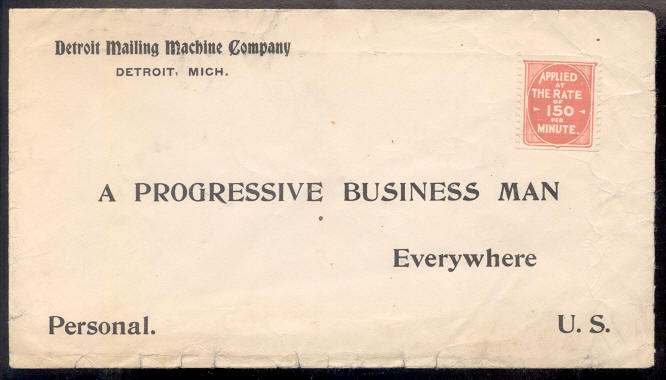
(Click image for 300 dpi scan)
| Mail-O-Meter Dummy Coils |
| Dummy Stamps Intro (click here) | Stampsjoann (click here) |
In 1906 when attempts to have his mailing machine produced in Chicago failed, Joseph J. Schermack took his idea and prototype for the machine to Detroit. There the Detroit Mailing Machine Company was formed to make and sell Schermack's machine. The 1906 patent covered "...the envelope sealing mechanism and the means for separating and applying the stamps." (The Stamp Machines and Coiled Stamps by George P. Howard, p32.)
At this time the Bureau of Engraving and Printing was not yet producing coiled stamps, so the Detroit Mailing Machine Company ran tests of Schermack's machine using coils made from sheets of Bureau gauge-12 perforated stamps. However, the fine perforations tended to separate when the machine was run at full speed; attempts to use imperforate coiled stamps also were unsatisfactory. Therefore, the company began to experiment with its own varieties of round-hole perforations, and later with its very successful hyphen-hole perforations.
Some references for the various private perforations (by Schermack and
others) are : Howard's book, the Scott Specialized CatalogUS
Stamps and Covers, and the November 1934 issue of
the American Philatelist.
The cover below appears to be a test example using the Detroit Mailing Machine Company corner card, a generic address, and a dummy test stamp that is previously unreported. Compare the stamp on the cover with the company- made stamp, Krause-Minkus (K-M) TT13, illustrated and discussed below. Similarities are the shield design and the color. Differences include the wording of the slogan, "...150 per minute" and the gauge 11.8 perforations (almost the gauge 12 the Bureau was using).

(Click image for 300 dpi scan) |
2. Or was the stamp used on an old Detroit Mailing Machine Company envelope when the company (by then called Mail-om-eter) was developing other machines?
Here is the stamp at 300 dpi
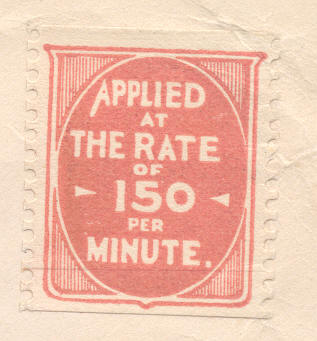
(Click image for 600 dpi scan) |
In 1907 the Detroit Mailing Machine Company was making the sealer/stamper machine designed by Schermack as well as perforating and coiling Bureau stamps that could be used in the machines. In 1908 the company (now called Schermack) made dummy stamps of its own to demonstrate its sealer/stamper machine. As shown below, the early stamps were red (K-M TT13). According to a pamphlet prepared by the company, the speed of the sealer/stamper was "conservatively" 10,000 per hour. (An application rate of 250 per minute would come to 15,000 per hour, assuming a continuous, unproblematic pace.) According to Howard, these red test stamps were used throughout 1908 and part of 1909. The stamps have the Schermack Type III perforations, the hyphen-hole type. This type of perforation was used into the 1920s.
TT13 with the Schermack hyphen-hole perforations:
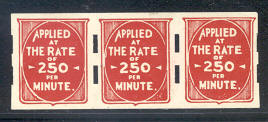
(Click image for a 300 dpi scan) |
In 1909, the Schermack Company became known as The Mail-om-eter Company. (Joseph Schermack had withdrawn from the company over some policy and machine changes; he then devoted his energies to developing vending machines.) Brown dummy stamps replaced the red stamps used previously for demonstration purposes. The strip of nine below shows both imperforate (K-M TT15) and hyphen-hole perforated (K-M TT14) stamps.
In later years the name of the company would be Mail-o-meter, rather than Mail-om-eter. This change may have occurred when the company began to make machines for printing meters.
TT15 (left) and TT14 (left) and TT14:
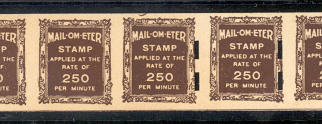
(Click image for a 300 dpi scan) |
Click <here> for a scan of the complete strip of nine.
A brown Mail-om-eter stamp (K-M TT14) that traveled the mails from Chicago to Marion, Ohio is shown below on a cover from the American Radiator Company. This brown stamp has a piece of a real stamp (Scott 344, Krause-Minkus 250) attached on the right side. The Mail-om-eter stamp was probably part of a leader or trailer strip that was attached to a strip of 2¢ stamps which were then affixed to the company's outgoing mail.
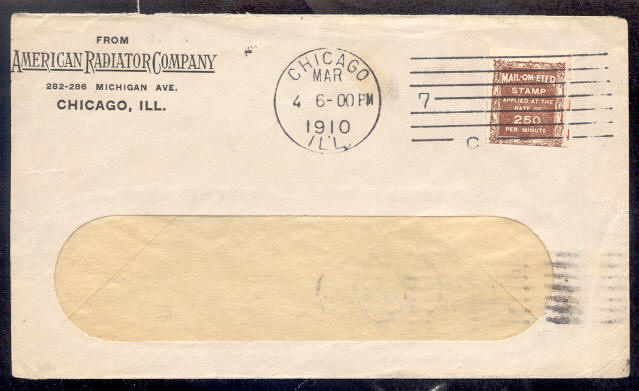
(Click image for a 300 dpi scan) |
In this 300 dpi scan of the stamp on the above cover, the red of the 2¢ stamp can be seen on the right.
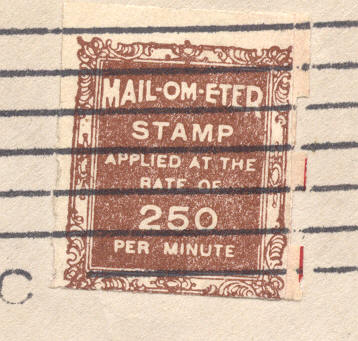 |
Click <here> to see the cert from APEX.
The receiving cancel on back of the envelope attests to the quick delivery in 1910. The cover was canceled in Chicago at 6:00 PM on March 4th and arrived in Marion, Ohio by 7:00 AM on March 5th.
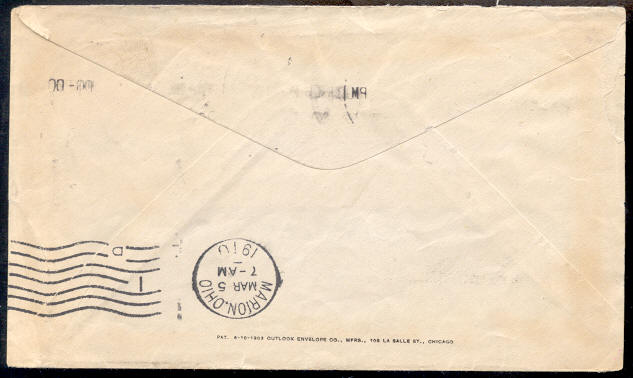 |
Click <here> for a contemporary American Radiator Company envelope franked with a SCOTT 344 , K-M 250.
For a time, the United States Post Office Department prohibited the preparation of stamps (perforating and coiling) in one city and then sending them to another. Companies in the business of selling stamp affixers/sealers/etc probably found this prohibition a deterrent to sales of their machines. For example, stamps perforated by Mail-om-eter perforations, were, no doubt, intended to be used on a Mail-om-eter sealer/stamper machine.
In addition, some companies, Mail-om-eter included, charged a bit more than face for coils which they prepared. Buyers expressed their displeasure with this added cost; as a result perforators, like Mail-om-eter, requested that the Bureau of Engraving and Printing provide coils that were already perforated.
The following letter, dated March 26, 1913, indicates the interest of the postmaster of Jacksonville in obtaining perforated coiled stamps which could be used on Mail-om-eter machines in that city. Attached to the letter is a line strip of five (K-M TT14) with Schermack Type III perfs.
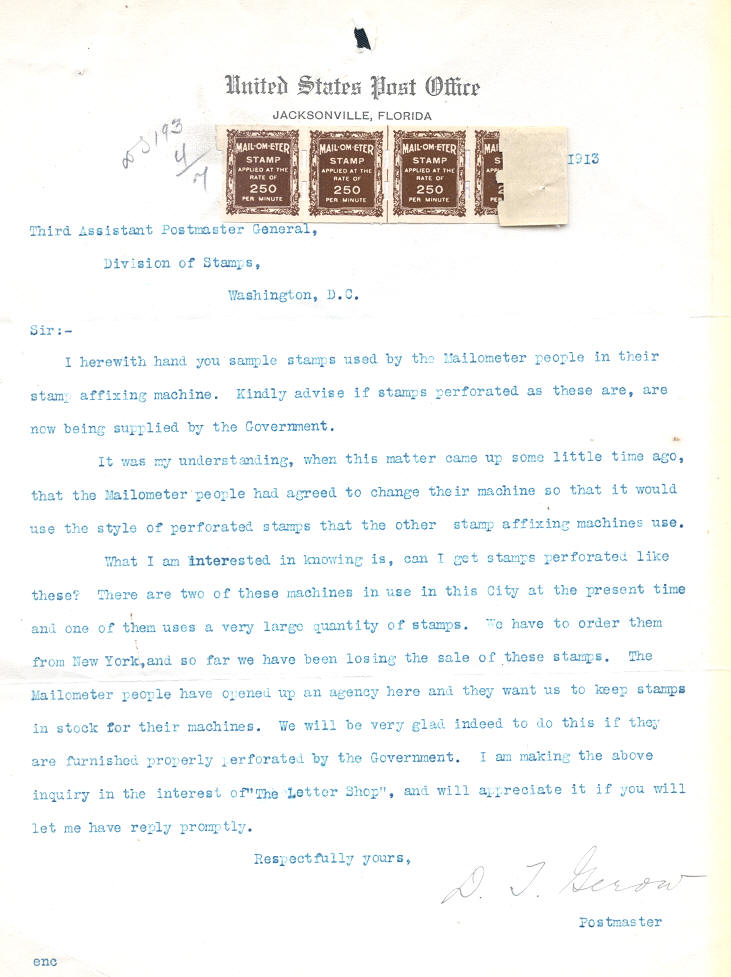
(Click image for a 300 dpi scan) |
Shown below is a cover with a corner card of the Multicolor Sales Company. Affixed to the cover, front and back, are Mail-o-meter stamps of a dark purple hue (K-M TT36C). At a glance the color of the stamp appears dark brown. This stamp has Schermack Type I perforations, the eight-hole type.
TT36C on the front of the cover:
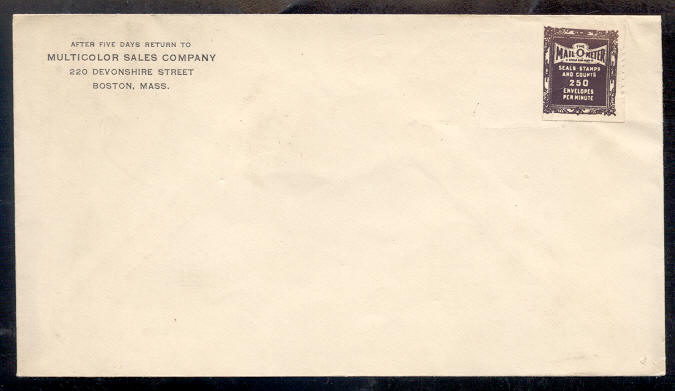
(Click image for a 300 dpi scan) |
A 300 dpi scan of stamp:
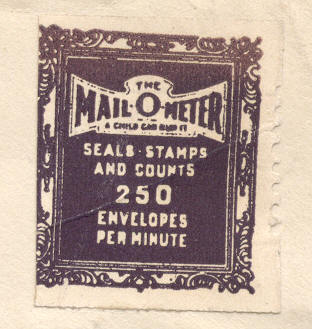 |
TT36C on the back of the same cover:
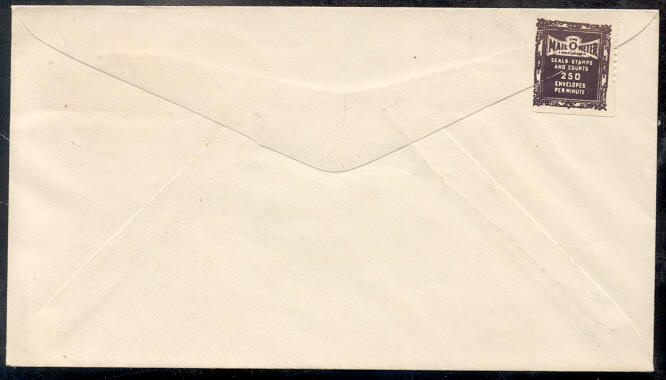
(Click image for a 300 dpi scan) |
The envelope below with the stamp stating that the affixer "Stamps, seals and counts 250 envelopes per minute" is an advertisement for the model D Mail-O-Meter machine as well as an advertisement for the envelope company. This red seal will be catalogued for the first time in the 2004 edition of the Krause-Minkus Standard Catalog ofU.S. Stamps. The stamp has standard perforations (10.2).
Also of interest is the possible dating of this envelope: The Schermack Mailing Machine Company became the Mail-om-eter Company in about 1909. The ad on the cover says that the company has "had thirteen years experience in the mailing machine business" which would make this cover circa 1922.
Unlisted - previously not documented dummy stamp:
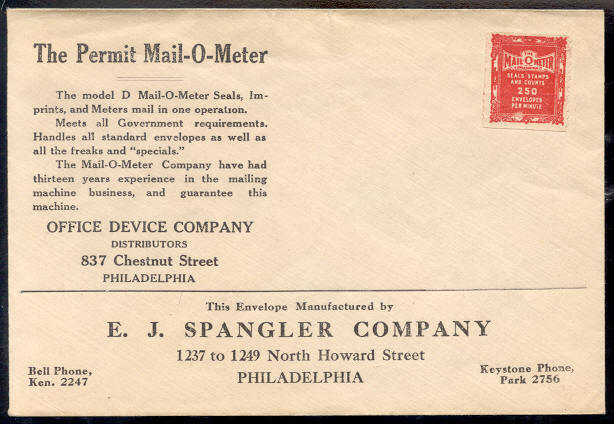
(Click image for a 300 dpi scan) |
A 300 dpi scan of the above stamp similar in design to TT36C but printed in red and perfed 10.2:
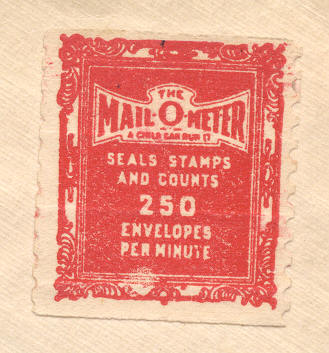 |
A 100 dpi scan of the back of the envelope.
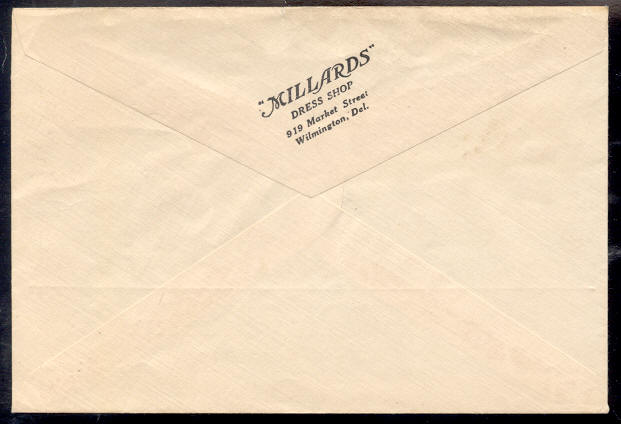 |
Another cover that traveled through the postal system is this postcard posted with only a red Mail-o-meter stamp (K-M TT61) that states, "Seals, stamps and counts 10,000 envelopes per hour." The stamp on this 1935 cover has standard perforations, perf 10 (actual 10.2). Although this cover should have been rated postage due 1¢, it was delivered with no due indicated. Use of this stamp and the next one shows that "dummy" stamps were still being used by Mail-o-meter into the 1920s, 1930s and early 1940s.
TT61 on the 1935 card:
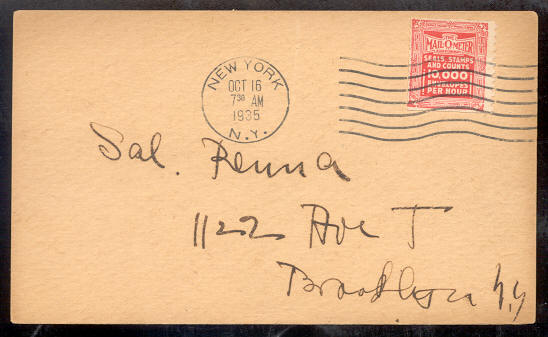
(Click image for a 300 dpi scan) |
A 300 dpi scan of stamp:
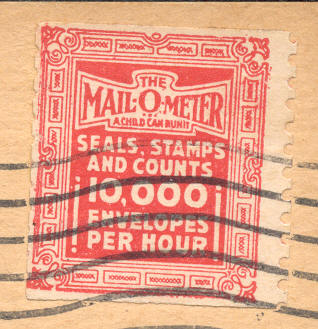 |
The message on the card can be seen below.
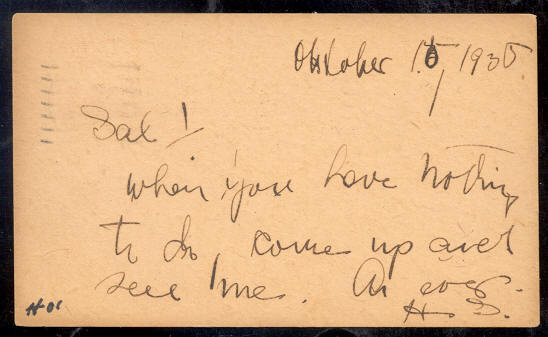 |
I welcome additional information about these dummy stamps and their usage.
| Dummy Stamps Intro (click here) | Stampsjoann (click here) |